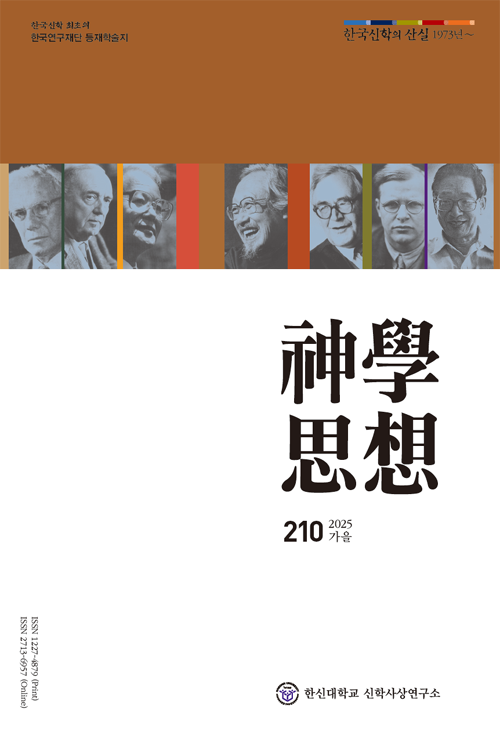- 영문명
- Vision and Redemption : A Theological Reappraisal of the Fiery Serpent Incident (Num 21:4-9
- 발행기관
- 한신대학교 신학사상연구소
- 저자명
- 이충열(Choong-Ryeol Lee)
- 간행물 정보
- 『신학사상』210집(2025년 가을호), 99~132쪽, 전체 34쪽
- 주제분류
- 인문학 > 기독교신학
- 파일형태
- 발행일자
- 2025.09.30

국문 초록
본 연구는 불뱀 사건(민 21:4-9)을 문학적·공시적 관점에서 분석하여 그 신학적 의미를 규명하고자 하였다. 본문의 문학적 구조 분석을 통해, 사건의 전개가 불평-심판-회개-중보-구원이라는 순차적 내러티브 구조를 따르고 있음을 확인하였다. 또한 본문의 내러티브 전개, 히브리어 어휘 분석, 그리고 놋(구리)의 상징성에 대한 종합적 고찰을 바탕으로, 기존 연구를 보완하며 해석의 지평을 확장하는 데 기여하고자 하였다.
분석 결과 불뱀 사건은 민수기 내 다른 불평 사건들과 달리 하나님이 직접 원망의 대상에 포함됨으로써 죄의 심각성이 한층 강조되며, 모세의 중재 없이 즉각적인 심판이 내려졌다는 점에서 독자적인 특징을 지닌다. 백성이 회개했음에도 불구하고 뱀이 제거되지 않은 이유는, 제거되어야 할 대상이 단순히 외적 현상이 아닌, 백성의 내면에 자리한 불평과 불신 그 자체였기 때문이다. 모세가 불뱀을 놋으로 제작한 이유는 놋이라는 재료가 지닌 제의적·상징적 의미(정결, 심판, 구원)를 통해 해석할 수 있다. 놋뱀을 ‘보는’ 행위는 단순한 시각적 응시가 아니라, 하나님의 말씀에 대한 신뢰와 순종의 결단을 요구하는 상징적 행위로 이해된다. 이는 놋뱀을 통한 치유의 메커니즘이 집단적 구원에서 개인적 선택과 응답의 차원으로 전환됨을 의미한다. 또한 민수기에서 하나님의 재앙 이후 생존을 긍정적으로 서술한 유일한 본문인 21장 9b절은 생존자 수를 기록하기보다, 하나님의 치유 방식에 믿음으로 응답한 개인의 행위를 통해 ‘산 자’ 개념을 신학적으로 확장하고 있음을 보여준다.
영문 초록
This study examines the fiery serpent incident in Numbers 21:4-9 from a literary-synchronic perspective to elucidate its theological import. A structural analysis of the narrative reveals a sequential progression of murmuring-judgment-repentance-intercession-salvation that is unique within the wilderness rebellion traditions. Furthermore, drawing upon a comprehensive analysis of the narrative progression, Hebrew lexical usage, and the symbolic significance of bronze, this study aims to augment existing scholarship and expand the interpretive horizons of the text.
The analysis reveals that the fiery serpent episode possesses distinctive features that set it apart from other murmuring narratives in the book of Numbers. Uniquely, God is explicitly named as the object of the people’s complaint, thereby underscoring the heightened severity of their sin. Moreover, divine judgment is executed immediately, without the customary intercessory role of Moses. The serpent is not removed even after the people’s repentance, indicating that what required removal was not merely external symptoms, but the very murmuring and unbelief embedded within the hearts of the people. Moses’ use of bronze in crafting the serpent can be interpreted through the ritual and symbolic meanings associated with the material, namely purification, judgment, and salvation. The act of “looking” upon the bronze serpent is not to be understood as a passive visual gesture, but rather as a symbolic action demanding trust in and obedient response to the word of God. This suggests that the healing mechanism mediated through the bronze serpent signals a shift from collective deliverance to an individual decision of faith. Furthermore, Numbers 21:9b, uniquely among the plague narratives in the book, does not record the number of survivors, but rather reveals a theological expansion of the concept of ‘the living’ as those who respond in faith to God's provision of healing.
목차
Ⅰ. 서론
Ⅱ. 불뱀 사건의 역사적·문학적 배경
Ⅲ. 불뱀 사건의 본문 구조와 내러티브 분석
Ⅳ. 결론
참고문헌
키워드
해당간행물 수록 논문
참고문헌
최근 이용한 논문
교보eBook 첫 방문을 환영 합니다!

신규가입 혜택 지급이 완료 되었습니다.
바로 사용 가능한 교보e캐시 1,000원 (유효기간 7일)
지금 바로 교보eBook의 다양한 콘텐츠를 이용해 보세요!


